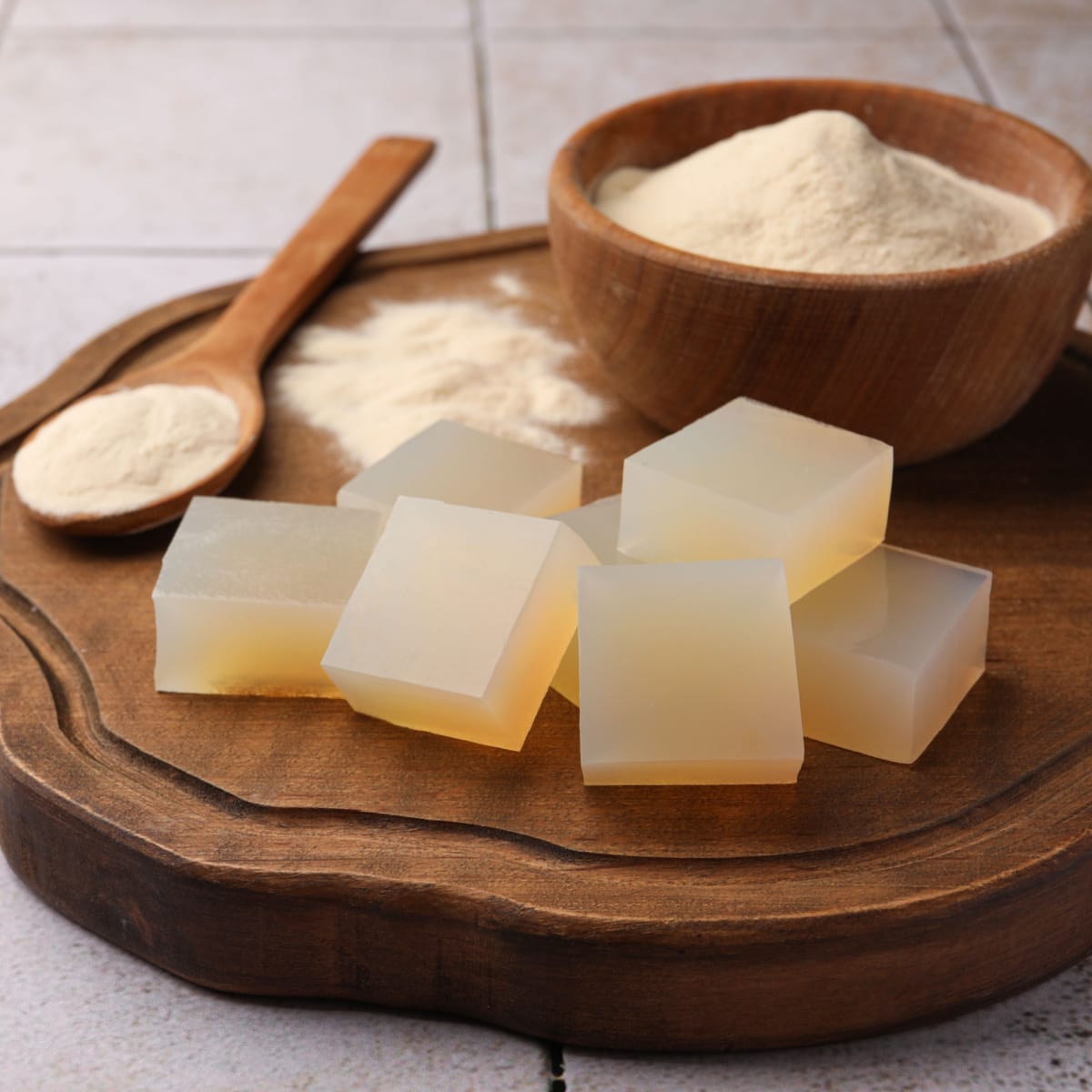Agar agar is a plant-based gelling agent derived from seaweed, commonly used in cooking and food production.
It’s a vegetarian alternative to gelatin and is used to thicken various dishes, including desserts, jams, and jellies.

Because of its strong gelling properties and lack of flavor, agar agar is a versatile ingredient in both sweet and savory recipes.
Learn how to use it today!
What Is Agar Agar?
Agar agar is a natural gelling agent derived from certain types of seaweed. This seaweed primarily comes from Japan and China.
Manufacturers boil the seaweed to extract the agar agar. Then, they dry it and form it into bars, strands, powder, or flakes for commercial use.
People frequently use it in vegan and vegetarian cooking and food preparation. It’s a popular substitute for gelatin, which is derived from animal products.
Agar agar is odorless, tasteless, and 100% calorie-free.
Because of all that, it has recently expanded beyond the vegan and vegetarian markets. The health-conscious and specialty diet crowds use it often, too.
To use it, you mix it with water and boil it. It becomes gel-like and perfect for puddings, jellies, and certain desserts.

Agar Agar vs. Gelatin
The primary distinction between agar agar and gelatin is that agar agar is vegan-friendly. Gelatin comes from livestock collagen (bones, skin, cartilage, tendons). However, that’s not the only difference between the two.
Agar agar’s melting point (185 degrees) is much higher than gelatin’s (95 degrees). Therefore, you must boil agar agar to make it set. You only need to add gelatin to warm water.
Additionally, agar can set at room temperature and does so far more quickly than gelatin. Gelatin requires refrigeration to set.
So, what does all that mean for the final products made with each ingredient? Typically, agar agar dishes will be firmer than those made with gelatin.
Gelatin dishes will be more jiggly and creamier. They don’t hold up as well as agar dishes when exposed to room temperature temps, though.
Different Varieties
All agar agar comes from the same algae. However, manufacturers sell it in different varieties. There are four main agar agar varieties:
- Powder
- Flakes
- Bars
- Strands
You find powder and flakes much more often than bars and strands. Powdered agar is the least expensive version. It’s also easiest to work with and dissolves almost instantly.
Agar flakes require a few more minutes in the water before dissolving. You also have to blend the mixture to make it smooth.
Agar bars and strands are harder to find. But if you have them, toss them in a blender to process them into powder.
Substitute powdered agar at a 1-to-1 ratio for gelatin. When using flakes, add about 1/3 of the amount of gelatin the recipe requires.
There are also flavored varieties of agar agar and colored varieties.

How to Use and Cook with Agar Agar
The most common use for agar agar is as a vegan alternative to gelatin. You can use it in tons of recipes that call for gelatin, including:
- Gummy candies
- Jellies
- Jams
- Puddings
- Cheesecakes
- Mousses
- Certain ice creams
- Etc.
How you cook with agar agar will depend on the particular recipe you’re making. However, there are a few basic steps to using this ingredient. Here’s what they are:
1. Dissolve the Agar Agar in Water
When substituting agar agar for gelatin, use the following conversions:
- Agar agar powder. Substitute an equal amount of powder for gelatin.
- Agar agar flakes. Use 1/3 of the required amount of gelatin.
- Agar agar bars or strands. Process into powder using a blender. Then, substitute at a 1-to-1 ratio.
Furthermore, you need about 1 teaspoon of powder for every 1 cup of liquid in your recipe. If you’re using flakes, you need 1 tablespoon for every cup of liquid.
2. Boil the Mixture
Once you’ve added the appropriate amount of agar to water, boil it. Use a small saucepan and bring the mixture to a boil over medium-high heat. Once it reaches a boil, let the mixture simmer for another 5 to 7 minutes until it thickens.
3. Use the Gel-Like Mixture As Required
Next, simply add the gel-like mixture to your recipe as required. Then, leave it at room temperature for about an hour to set.
You may have to refrigerate the finished dish to let it chill if it’s supposed to be enjoyed cold.
Be careful with dishes with highly acidic fruits (lemons, limes, strawberries, etc.). These recipes will require additional agar to set properly.
What Does Agar Agar Taste Like?
Agar agar has no taste. It’s 100% tasteless. It has no taste or odor, making it the perfect gelling agent.

Where to Buy Agar Agar
Finding agar agar was pretty difficult several years ago. But fortunately, it’s recently become more popular. You can usually find it at most major supermarkets.
Look for it in the store’s vegan food or natural food sections. If you can’t find it at your local grocery store, check specialty health food stores or Asian markets. If all else fails, you can find the powder and flakes online. The powder is the cheaper of the two.
How to Store
Fortunately, it doesn’t matter what type of agar agar you have when it comes to storage. Flakes, powder, strands, and bars are all stored the same way.
Keep the agar agar in an air-tight container. Then, place it somewhere cool, dry, and away from direct sunlight or heat sources.
It should remain fresh for up to 8 months, possibly a little longer.










